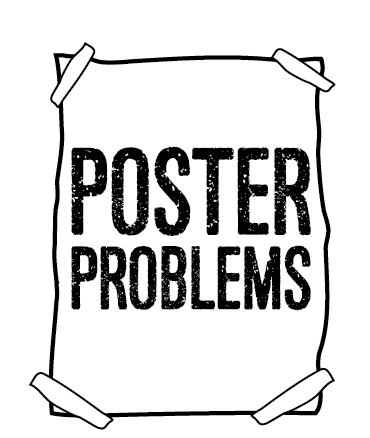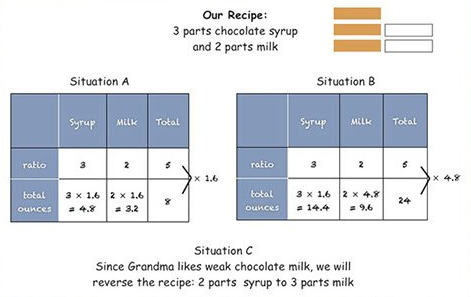The Intensity of Chocolate Milk
Sixth Grade Poster Problem:Ratios and Proportional Reasoning
This problem is designed to help students use ratio language and concepts by focusing on a single compelling problem context – making chocolate milk. Questions in this problem use both part-to-part ratios and part-to-whole ratios.
Downloadable Materials
Learning Objectives:
- Understand the concept of ratio and use ratio language to describe a ratio relationship between two quantities.
- Use ratio and rate reasoning to solve real-world and mathematical problems.
Common Core State Standards for Mathematics:
- 6.RP.A.1 and 3
1. LAUNCH
Show Slide #1.
Ask students: “Have you ever made chocolate milk at home? How did you do it?” Allow one or two students to describe how they make chocolate milk by mixing the chocolate syrup and milk.
Engage students in a discussion about making chocolate milk. Lead the discussion to elicit ideas about the following.
- Different ways of making chocolate milk that result in more or less “chocolaty” final product
- Amount of milk or chocolate syrup used
Tell students that they are about to watch a video showing two different recipes used to make chocolate milk.
Before you start the video, set up the discussion that will follow by asking:
- How are these recipes the same?
- How are they different?
- Which is better?
Show Slide #2
(video).
2. POSE A PROBLEM
Show Slide #3.
We know that the main ingredients of chocolate milk are chocolate syrup and milk. But how much of each ingredient should you use? Steven is an “expert” at making chocolate milk that he thinks is “just right.”
Discuss Steven’s recipe.
Show Slide #4
as you ask these questions and check the appropriate boxes to highlight the parts and whole.
Ask students:
What are the parts in Steven’s recipe? Answer: chocolate syrup, milk
What is the whole? Answer: chocolate milk
Ask students:
Does Steven’s recipe tell you exactly how much (quantities) chocolate syrup and milk to use? Answer: No, it gives the ratio of the two ingredients
Can you use Steven’s recipe to make a single glass of chocolate milk? Answer: Yes
Could you use this recipe to make enough for all of the students at your school? Answer: Yes
Show Slide #5.
Ask students:
Is Steven’s recipe more intense, less intense, or the same as the two recipes from the video? Answer: Steven’s recipe is more intense than the recipe on the left side of the video, but less intense than the recipe on the right]
Distribute Handout #1.
Handout #1 Answer Key
3. WORKSHOP
Show Slide #6.
Tell students:
In this workshop, your group will create a recipe for chocolate milk - you can choose the intensity. The intensity of your recipe should be different from Steven’s.
You will then make a poster that describes how much chocolate syrup and how much milk to use for three different situations.
For Situation A and Situation B, use the same recipe. Situation C asks you to modify your recipe for someone who likes less intense chocolate milk.
Situation A: Chocolate milk for just yourself: Use your recipe to make one 8-ounce glass of chocolate milk.
Situation B: Chocolate milk for a group: Use your recipe to make four 6-ounce glasses chocolate milk.
Situation C: Lastly, answer the following question: your grandma likes very weak (not intense) chocolate milk. How would you change your recipe to make a glass of chocolate milk for your grandma? Show how you would change your recipe to make 8 ounces of chocolate milk for your grandma.
Distribute Handout #2.
Tell students:
After you choose your recipe, make a poster.
Your poster should include mathematical representations (mathematical drawings, diagrams, tables, equations, or graphs) to show how you used your recipe in each situation. Include both the ratio of chocolate syrup and milk, and the number of ounces of each ingredient for your recipe. Show all your steps and consider your quantities carefully—some numbers will be easier to work with than others.
4. POST, SHARE, COMMENT
Have students post their posters around the classroom.
Encourage students to travel around to view the posters created by other groups. Students should be encouraged to write questions for other groups by attaching a small adhesive notes.
During this time, teachers should be reviewing all the posters and considering which to highlight during Phase 5 (Strategic Teacher-led Discussion)
5. STRATEGIC TEACHER-LED DISCUSSION
Facilitate a discussion that uses the students’ work to highlight some critical mathematical concepts and the representations that can be used. Here we have gathered three possible samples of student work, showing different levels of sophistication. Some students who pick “unfriendly” numbers will struggle. Rather than hide this difficulty, take the time to show students examples that didn't work perfectly, and why.
What to look for in terms of numbers chosen for the ratios:
Situations A and B are easier to solve when the parts in the ratio add to 2, 4, or 8. Some students may figure this out and intentionally choose numbers that make the computations easy. Choosing numbers that simplify calculations (when that is an option) is an important practice to highlight. Here is how some easy ratios will scale for Situation A.
- 1:3 → 2 oz chocolate and 6 oz milk
- 1:1 → 4 oz chocolate and 4 oz milk
- 3:5 → 3 oz chocolate and 5 oz milk
Solving for the number of ounces is much more challenging when the parts in the ratio do not add to 2, 4, or 8. For example, if the ratio is 2:3 then you have to multiply each part by 8/5 to make a total of 8 ounces of chocolate milk. The results are
- 2:3 → 16/5 = 3.2 oz chocolate and 24/5 = 4.8 oz milk (see sample poster 3).
What to look for in terms of diagrams:
The types of diagrams will also be uneven in their level of sophistication. The least sophisticated diagrams do not use a scale.
More sophisticated diagrams might not even look like cups anymore, but will preserve the relative sizes of the parts.
More sophisticated diagrams might not even look like cups anymore, but will preserve the relative sizes of the parts.
- Least sophisticated: Drawings of cups not to scale
- More sophisticated: Diagrams correctly showing proportions
- Most sophisticated: Stacked bar graphs showing part:part or part:whole (as in Poster A)
What to look for in terms of solution strategies:
- Less sophisticated: Repeated adding
- More sophisticated: Scaling
- Most sophisticated: Setting up equations and solving. But check for understanding; some students get good at symbols but lose their connection to the situation.
6. FOCUS PROBLEM: Same Content in a New Context
Distribute Handout #3.
Handout #3 Answer Key
The Focus Problem challenges students to use the ratio reasoning developed in "The Intensity of Chocolate Milk" to solve a problem involving a ratio with four parts.
Answers to Handout #3:
- orange:pear 3:4
- pineapple:grape 6:3 = 2:1
- fraction of pear in fruit salad = 4/16 = 1/4
- 2 lbs of fruit salad requires: 1/2 lb pears, 3/8 lb oranges, 3/4 lb pineapple and 3/8 lb grapes
- With only 1 lb grapes, you need: 1 1/3 lb pears, 2 lbs pineapple, and 1 lb oranges
Project funding provided by The William and Flora Hewlett Foundation and S.D. Bechtel Jr. Foundation.
This work is licensed under a Creative Commons Attribution-NonCommercial-ShareAlike 4.0 International License.





